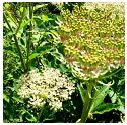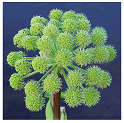main |
sidebar

 Angelica archangelica or Garden Angelica plant is awesome in its appearance and its course texture makes it a special addition to your indoor herb garden. Angelica is similar to the mustard plant in size, so look for a smaller variety for your indoor herb garden.
Angelica archangelica or Garden Angelica plant is awesome in its appearance and its course texture makes it a special addition to your indoor herb garden. Angelica is similar to the mustard plant in size, so look for a smaller variety for your indoor herb garden.
Angelica herb is a member of the parsley family. It is a hardy perennial and will self seed in your garden if you want it to - you need no more than one plant in a 5ft (150cm) square. It is a biennial herb, which means it is a short-lived perennial plant.
This giant-size herb (it can grow up to 7 feet in height) originated in Northern Europe and was brought to England in the Middle Ages. The leaves, stalks, roots and seeds were used, and the root is still used today for flavouring wines, and for liqueurs such as Chartreuse. The leaves also make a refreshing herbal tea which has a tonic effect, the stems are well known in their candied form for cake decoration. The whole flavor of the plant is warming and aromatic.
Angelica archangelica has bright green basal leaves which divide into oval leaflets. Yellowish-green leaves grow to 2 ft. long. The flowers will grow taller than the plant itself and will bloom in tiny yellow or white clusters. If flower heads are removed, plant will grow on as perennial. If not, it will die back after flowering.
The plant is also said to bloom on May 8th the feast day of Michael the Archangel and therefore named "angelica" and also called "the root of the holy ghost".
There are several legends of the angelic herb but they all have one common theme - the angelica herb was originally used to ward off evil spirits and witchcraft.
So whether you grow Angelica for the plant's majestic beauty or for the culinary, medicinal or aromatic properties, or just to ward off evil - this plant is an excellent addition to any herb garden.
Culture
You also can propagate angelica from root cuttings.
Uses
All parts of the Angelica plant may be used. The flavor is slightly reminding of celery and is sometimes called "wild celery”. Young stems can be used as a substitute for celery. Mincing the leaves will add a wonderful flavor to fish and pork dishes and is often added to stewed fruits to reduce the tartness and add a sweet taste. The northern regions of Siberia eat the roots raw or cooked with butter and consider Angelica a vegetable.
 The stems and seeds are used in candy making and for flavoring liqueurs. The dried leaves are used in the preparation of hop bitters. Fresh leaves can be chopped and used in salads or other dishes and can be added to sour fruits. Chopped leaves can replace some of the sugar in fruit pies. Brew seeds into sweetish tea. Additionally, leaves or roots can be cooked with rhubarb or gooseberries – it lessens the acidity. Candied Angelica is used extensively in decorating cakes.
The stems and seeds are used in candy making and for flavoring liqueurs. The dried leaves are used in the preparation of hop bitters. Fresh leaves can be chopped and used in salads or other dishes and can be added to sour fruits. Chopped leaves can replace some of the sugar in fruit pies. Brew seeds into sweetish tea. Additionally, leaves or roots can be cooked with rhubarb or gooseberries – it lessens the acidity. Candied Angelica is used extensively in decorating cakes.
Candied or crystallized angelica
Always use the young green stems from a plant in its second year of growth. Cut the stems into six-inch long pieces and soak overnight in cold water. Drain and blanch in a pan of boiling water for about two minutes. Drain and allow cooling. Peel off the outer skin. If it resists, it needs more blanching.
Make syrup by boiling one cup of sugar with an equal amount of water until the sugar is well-dissolved (five to ten minutes). Simmer the peeled angelica stems in the syrup for 20 minutes. Remove the angelica from the syrup and refrigerate both separately for four days. Reheat angelica in the syrup and cook at a low hit for 20 minutes or until candied. Drain the angelica and dry on racks set over waxed paper. Store it in airtight jars.
The angelica herb is used in medicine for treatment of fevers and colds, flatulence, colic and many stomach issues. At the end of World War I, people chewed on the root in the belief that it would protect them from the then influenza epidemic. Angelica is also said to strengthen the heart. It helps to regulate menstruation while easing menstrual pain.
Angelica has many medicinal uses both internal and external but is best known for curing respiratory and digestive illnesses. It is useful in treating anorexia nervosa, cystitis and bronchitis.Angelica herb has antibacterial and antifungal qualities.
Angelica has stimulating properties when used in a tea form and can be used to treat digestive upsets. Dried leaves are used to make a tea to improve energy, stimulate circulation and reduce flatulence. Angelica should not be used by diabetics or taken in large does while pregnant. Avoid sun exposure immediately after taking.
The leaves are used in herb pillows – it is believed to have a calming effect.
Added to your bath water, angelica will reputedly remove any curses or spells that has been placed on you.
Related Articles:
How to grow medicinal herbs, cooking herbs and tea herbs indoors. Holistic guide about healing nature of herbs in your garden. Moon gardening Calendar, indoor garden kits and herb garden seeds.
LINKS
Video Wall
Followers
About Me

- Zoy
- Aurora, Canada
- Holistic lover, enjoy biodynamic gardening, natural life style and herbal medicine.
Awesome Root of the Holy Ghost.
 Angelica archangelica or Garden Angelica plant is awesome in its appearance and its course texture makes it a special addition to your indoor herb garden. Angelica is similar to the mustard plant in size, so look for a smaller variety for your indoor herb garden.
Angelica archangelica or Garden Angelica plant is awesome in its appearance and its course texture makes it a special addition to your indoor herb garden. Angelica is similar to the mustard plant in size, so look for a smaller variety for your indoor herb garden.The plant is also said to bloom on May 8th the feast day of Michael the Archangel and therefore named "angelica" and also called "the root of the holy ghost".
Culture
- Height 4-7 ft.
- Maintenance Easy.
- Pot Size 12 to 16" wide and at least 12" deep container.
- Seed Germination 21 to 28 days. The seed needs some light for germination.
- Seed Spacing Sow in shallow drills 1/8” (0,6cm) deep or scatter on the surface and cover with a thin layer of soil.
- Plant Spacing 0.6 to 1 m (2 to 3 feet) apart.
- Soil Requirements The soil should be deep, rich, moist and slightly acid.
- Growing Mix Mix 1 part garden soil, 1 part coarse sand or perlite, 1 part moist peat or humus (leaf mold) and a light dusting of lime.
- Fertilize Fertilize At least twice during the growing season. The preferred fertilizer is the use of plant spikes.
- Sun & Lighting Full sun to partial shade.
- Water Requirements Dry to Moist. Average water needs; water regularly; do not overwater.
Uses
Stems are boiled with jams to improve the flavour. Dried and ground leaves used in desserts, custards and pastries. Seeds can be used in pastry dishes. Angelica Oil from seeds and roots is used in gin and vermouth. Roots can be used in biscuits, cakes and breads.
 The stems and seeds are used in candy making and for flavoring liqueurs. The dried leaves are used in the preparation of hop bitters. Fresh leaves can be chopped and used in salads or other dishes and can be added to sour fruits. Chopped leaves can replace some of the sugar in fruit pies. Brew seeds into sweetish tea. Additionally, leaves or roots can be cooked with rhubarb or gooseberries – it lessens the acidity. Candied Angelica is used extensively in decorating cakes.
The stems and seeds are used in candy making and for flavoring liqueurs. The dried leaves are used in the preparation of hop bitters. Fresh leaves can be chopped and used in salads or other dishes and can be added to sour fruits. Chopped leaves can replace some of the sugar in fruit pies. Brew seeds into sweetish tea. Additionally, leaves or roots can be cooked with rhubarb or gooseberries – it lessens the acidity. Candied Angelica is used extensively in decorating cakes.Always use the young green stems from a plant in its second year of growth. Cut the stems into six-inch long pieces and soak overnight in cold water. Drain and blanch in a pan of boiling water for about two minutes. Drain and allow cooling. Peel off the outer skin. If it resists, it needs more blanching.
Make syrup by boiling one cup of sugar with an equal amount of water until the sugar is well-dissolved (five to ten minutes). Simmer the peeled angelica stems in the syrup for 20 minutes. Remove the angelica from the syrup and refrigerate both separately for four days. Reheat angelica in the syrup and cook at a low hit for 20 minutes or until candied. Drain the angelica and dry on racks set over waxed paper. Store it in airtight jars.
Added to your bath water, angelica will reputedly remove any curses or spells that has been placed on you.
Related Articles:
Subscribe to:
Post Comments (Atom)
Menu
Types of Herbs
Culinary Herbs
Medicinal Herbs
Tea Herbs
Template Design by SkinCorner | Template Image from Dapino-Graphics | Flowers images from yunphoto.net













2 comment.:
I’m glad to find so many useful and informative data on your website. fullbloomHydro
Not a perennial. Prefers moist soil and shadier sites.
Post a Comment